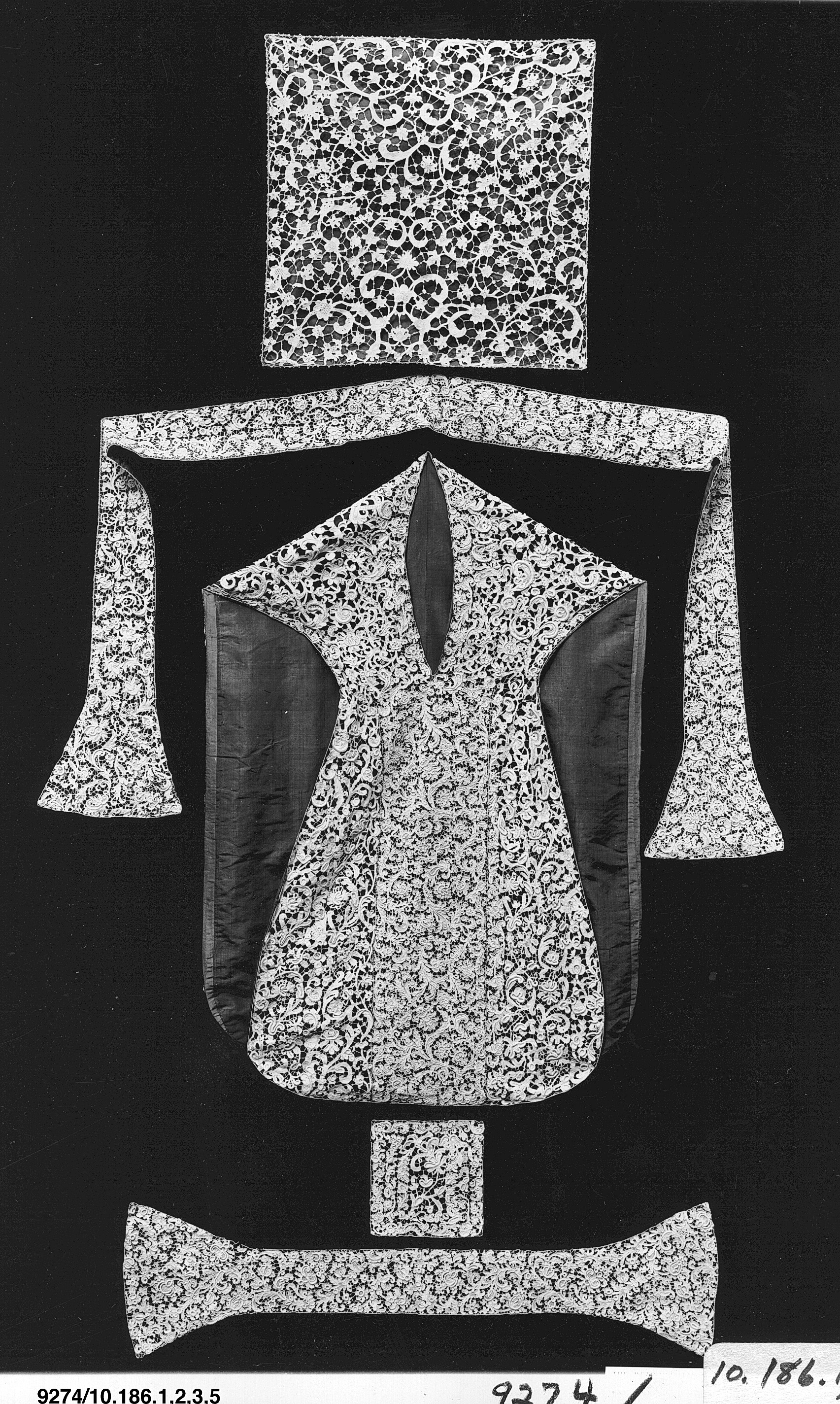Chasuble of needle lace
Not on view
Close analysis reveals that the swath of lace covering this rare chasuble has actually been assembled from over a dozen different pieces of Venetian gros point, arranged to fit the Roman silhouette. Needle lacemaking emerged in Venice in the last decade of the fifteenth century, and its elaborate openwork patterns, defined by negative space, were unlike any textile that had come before. This technique developed out of cutwork, in which a woven linen foundation is traced with a pattern which is then cut out, and stitches are worked back into the voided areas. Eventually this evolved into punto in aria (literally “stitches in air”), wherein the base fabric was no longer necessary and the stitches were worked directly onto parchment. Gros point needle lace was perhaps the pinnacle of this technique, with three-dimensional motifs worked so densely that they almost appear to be carved from ivory. The sculptural elements are padded with linen or wool fibers, and covered with thousands of buttonhole stitches in extremely fine linen thread.
Although gros point peaked in popularity between 1650 and 1670, it was incredibly time consuming to make and thus remained very valuable even after it fell out of fashion for secular dress. Given that lacemaking was common work in convents, it follows that a church could have had many pieces of lace on hand to contribute to a set of vestments. In Italy, the church continued to support the lacemaking industry, commissioning objects for ecclesiastical use long after the demand for gros point began to wane. The lace in this chasuble is predominantly made up of long, narrow borders which have been arranged in a mirrored pattern on the front and back. These vary in scale from dense patterns of smaller motifs forming an orphrey down the front and back, to larger, more wide-set motifs on either side. The narrowest strips outline the orphrey as well as the neck opening, and run around the back of the chasuble. Many individual motifs have been cut and rearranged to fill in gaps in the design, connected with bars of buttonhole stitches dotted with picots.
While gros point is the predominant type of lace represented on the chasuble, two other types of needle lace are also used. Point plat, literally meaning flat point, was a needle lace worked in similar scrolling patterns to gros point, but without any three-dimensional elements. To blend it more seamlessly into this chasuble, the point plat has had raised flourishes applied to the surface, but upon closer inspection it still retains a flatter effect overall. On the front of the chasuble at the bottom left, two pieces of tape lace are also incorporated, with similar raised elements attached to imitate gros point. Tape lace was a much quicker method of lacemaking wherein lengths of woven tape were arranged into a pattern and stitched together. Also known as Battenburg lace, its popularity peaked in the nineteenth century in competition with machine-made lace, but much earlier examples exist as well.
While wide bands of lace were a commonly used on albs, chasubles made entirely of handmade lace are extremely rare. There are very few extant examples in the world, but those known are a similar set of lace vestments at the Victoria and Albert Museum in London [inventory number 1411-1871], and a chasuble at the St. Gallen Textile Museum in Switzerland [inventory number 51480]. The chasuble in the collection of the Victoria and Albert is comprised of many strips of gros point borders, arranged in a mirrored pattern with a Y-shaped orphrey on the back. In contrast, the lace on the chasuble in St. Gallen appears to have been constructed of larger pieces of lace made to fit the garment, making it even more of an extreme rarity.
The vestment set of which this chasuble is a part was passed down as a family heirloom by the Priuli family of Venice. It includes the chasuble, a maniple [10.186.2], a stole [10.186.3], and a chalice veil [10.186.4]. Descending from a noble Hungarian lineage, the Priuli family relocated to Venice almost a millennia ago and were admitted to the Grand Council in 1100. Their family tree includes three Doges and four Cardinals, the most well-known being Antonio Priuli, who was Doge in Venice from 1618 to 1623. In 1907, one of the family’s heirs sold these rare vestments to Jacques Krakauer, a lace dealer in New York City. It was purchased by the Museum as a complete set in 1910.
[Elena Kanagy-Loux, 2017]
This image cannot be enlarged, viewed at full screen, or downloaded.
This artwork is meant to be viewed from right to left. Scroll left to view more.



